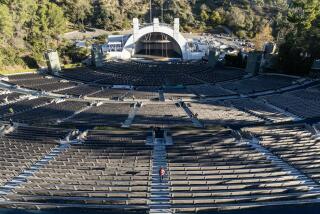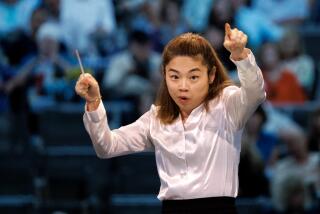Another Boston-L.A. Rivalry? : Music: Hollywood Bowl Orchestra, created after a record company lost the Boston Pops, debuts this week--in a recording studio. The session is part of a plan to give the ensemble an aura of Tinseltown glitter.
The Los Angeles Philharmonic’s newly formed Hollywood Bowl Orchestra is making its debut this week. But there isn’t an audience of thousands cheering it on, just an array of microphones and a passel of engineers and producers working with conductor John Mauceri and his players, about 90 local free-lancers and studio musicians.
The three-day recording session, conducted by Philips Classics at the former MGM Studios in Culver City, ends today. The next time the orchestra convenes will be for its official debut before an audience at the Hollywood Bowl on July 3. Then, there will be more recordings and finally an end-of-the-year tour of Japan.
It is not the usual order of events by which musical ensembles coalesce. Traditionally, an orchestra performs for audiences for years and develops a distinct “sound.” Recordings usually follow as kind of a documentation of achievement.
But this is not the usual orchestra. The fact is, the forces giving birth to this orchestra were motivated by different needs, some perhaps at cross-purposes. According to interviews with a Philips executive, the orchestra was conceived as a salable pops package with a hand-picked Mauceri--an “artistic package” that would be a strong drawing card in Japan. This week, it was rushed into the recording studio to have a product to sell on that tour.
Moreover, an examination of the ensemble’s genesis, choice of repertory and the casting of its music director provides a glimpse of the ever-expanding role of a record company in the life of today’s orchestras.
On the face of it, the Hollywood Bowl Orchestra is designed to fill in for the Los Angeles Philharmonic during its traditional summer season at the Bowl. This year, for example, the Philharmonic will play 10 fewer alfresco concerts, relinquishing those dates to the new Bowl orchestra. Eventually, the Philharmonic will have more time to pursue its goal to become more prominent on the international scene, Philharmonic officials said, such as at the Salzburg Festival where it is scheduled to perform in 1992.
But for Philips Classics, based in the Netherlands, the new orchestra is an attempt to replace the loss of the long-established Boston Pops, which left Philips two years ago for the newly created Sony Classical label. The loss of the Boston Pops to a strong competitor--especially in the Asian market--left the company grasping for a new product. Shortly thereafter Philips officials came up with the high concept of marketing an entirely new orchestra that would trade on the glittery aura of Hollywood and the attraction of the Bowl itself.
To do so, Philips is going to great lengths to make a distinction between the Hollywood Bowl Orchestra and the Boston Pops. Costa Pilavachi, Philips vice president of artists and repertoire, said: “Nobody involved in this project feels that the Hollywood Bowl Orchestra and the Boston Pops have that many similarities. The programming will be quite different; we do not want to do what Boston Pops does, or what Cincinnati Pops does. . . .”
The Hollywood Bowl Orchestra has thus avoided the pops label--instead promoting its more versatile repertory. Few details of its inaugural recording were available this week, and as late as three days before the recording sessions were to start, the repertory had not been chosen. A Philharmonic spokeswoman said the final cuts on the recording, titled “Hollywood Dreams,” would be made at the last session today.
But the orchestra’s programmatic themes for its concerts at the Bowl this summer indicate a classic pops lineup:
* July 3 and 4 will be traditional stars-and-stripes fare.
* July 12 and 13 will be a Gershwin program.
* July 19 and 20 will be with the theme “Broadway Dreams.”
* Aug. 9 and 10 are billed as “The Great American Concert.”
* Aug. 16 and 17 will be a program of Hollywood film music.
* Aug. 23 and 24 is a “Tchaikovsky Spectacular” with Vladimir Feltsman.
Although this lineup sounds like pops music and a pops season, when asked if the Hollywood Bowl Orchestra is a pops ensemble, Philharmonic managing director Ernest Fleischmann tersely replied: “No.”
Norma Flynn, a spokeswoman for the Philharmonic, elaborated. The orchestra “will be doing more than pops stuff,” she said. “They’ll be doing things from pops all the way over to opera, and maybe, Mahler. It’s not a pops orchestra. This is going to be an orchestra with a wide range, a very versatile range of musical styles, into the classical.”
Pilavachi said that he planned to exploit the “romance and glamour of Hollywood” and market that around the world. “There’s not a single American who doesn’t know what the Hollywood Bowl is and what it stands for, and the funny thing is, there’s no one in Japan who doesn’t know either,” Pilavachi said. “The Hollywood Bowl is already famous in Japan for the beauty of its natural setting. It’s a site; the way people know the Empire State Building. They know the Hollywood Bowl. It’s a landmark; it’s on the itinerary of every Japanese tourist in L.A.”
But don’t mention Hollywood’s glamour to Fleischmann. “Mauceri does not have a Hollywood image and we do not cultivate one. That’s Philips’ problem; we’re not in the business of selling recordings,” Fleischmann said.
Further indications of Philips’ role in creating the orchestra and selecting its music director came from Pilavachi’s explanation on how the project came about.
When John Williams and the Boston Pops left Philips after a 10-year, 20-CD legacy, “it left a gap in the Philips catalogue. And naturally, one of my first mandates at Philips was to find a way to offer our market something along the lines of the Boston Pops, but not the same. So we cooked up the idea of the Hollywood Bowl. It’s a terrific idea.”
Last February, Pilavachi arrived in Los Angeles and had lunch with the Fleischmann and his artistic administrator, Ara Guzelimian. Pilavachi said: “I think Ernest has been considering (the Hollywood Bowl Orchestra) for a long time. When I told Ernest we had an idea in mind that involved a Hollywood Bowl Orchestra with (Scottish Opera’s) John Mauceri, he said: ‘I knew that you were going to talk to me about the Hollywood Bowl.’ ”
Fleischmann corroborates Pilavachi’s account. Fleischmann said the orchestra was established “because of Philips. It was an opportunity to do something at very little or no cost to the (Los Angeles Philharmonic Assn.), which would alleviate the workload of the Los Angeles Philharmonic, the hardest-working orchestra in the country. And, at the same time, improve the quality of our performances even further.”
And just as Philips provided the missing ingredient that allowed the Bowl Orchestra to spring to life, the double-session studio work and the upcoming tour of Japan were part of promotional aspects of the packaging.
“Philips is very much involved with every aspect of the Hollywood Bowl Orchestra’s career,” Pilavachi said. “Of course, our company in Japan will be very much a part of the tour and is very much a part of the planning from the first stage. That’s why we are rushing to record. So when the orchestra does go to Japan there will be a couple of recordings on the market.”
More to Read
The biggest entertainment stories
Get our big stories about Hollywood, film, television, music, arts, culture and more right in your inbox as soon as they publish.
You may occasionally receive promotional content from the Los Angeles Times.










